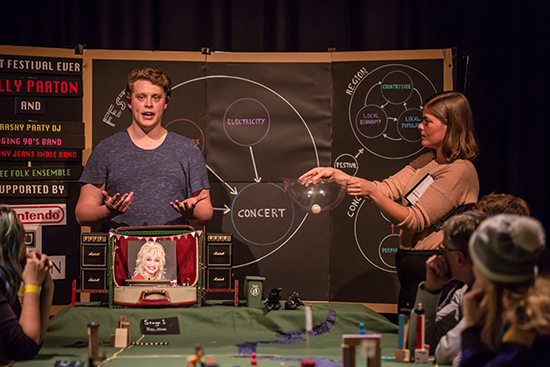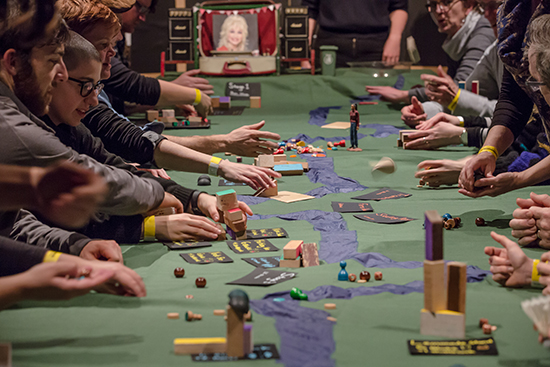Gaming climate change
Teik Kim Pok: Boho Interactive: The Best Festival Ever

Best Festival Ever
Imagine wading ankle-deep in mud for 300 metres only to be blinded by floodlights and greeted by a herd of bleating sheep and a passionate, rain-drenched festival crowd singing the chorus of “Jolene” accompanied by Dolly Parton on acoustic guitar. This is the emotionally charged and comically chaotic finale to The Best Festival Ever, an interactive performance work in which the audience addresses the ecological viability of an outdoor musical extravaganza and how it came to be so vulnerable to the elements.
Thankfully for us, seated around a green-felted banquet table, the festival manifests as a collection of miniature figurines, plastic toy trucks and wooden blocks strewn across a scaled-down representation of sprawling cattle farmlands.
Billed as “part-theatre show, performance lecture and board game,” this immersive experience is a Boalian exercise in confronting the ecological impact of collective decision-making and the brainchild of an alliance between two distinct interdisciplinary collectives, Boho Interactive and Applespiel. Boho is represented by theatre-maker David Finnigan and science writer David Shaw who provide the directorial and scientific framework drawn from their research into game theory and systems science, while Appelspiel display the ‘rockumentary’ credentials they established in Appelspiel Make a Band and Take on the Recording Industry. Putting together a music festival provides the narrative scaffolding for a board game punctuated with instructive climate science sound bites in a fast-moving 80-minute production.
Appelspiel’s Nathan Harrison, Nikki Kennedy and Rachel Roberts serve as a tight team of presenters, straddling the duties of game hosts and lecturers while recounting the emergence of the festival through the experience of three avatars: Valerie Kay, an emerging festival producer; Liz Hausman, a local independent musician looking for one final taste of guitar heroics on the eve of enlisting in the army; and Eliot Bulson, the hyped-up festival-goer who works at the local carwash, who helps measure patron experience and is a subtle romantic foil. Audience members are occasionally called upon to be scene partners with prepared dialogue cards to read from.
Tightly-timed and stress-inducing tasks are administered as we build the festival, while being reminded of the scoring system in which we can win “happy festival goer” figurines and avoid accumulating miniature garbage bags which signal negative environmental impact. When bags outnumber figurines, the festival is deemed a failure and vice versa a success.

Best Festival Ever
The first act takes the audience through the early stages of project management. We begin with a festival programming exercise that is tied to a sponsorship procurement that involves keeping mini-barrels balanced on an inverted umbrella through which we summon the unholy trinity of News Corp, Uber and Nintendo to pledge cash for Parton and her support acts, generically named the “aging 90s band” and “YouTube Sensation.” We are swiftly directed to unlock wooden blocks with coloured dice in order to accumulate resources—food stalls, roads, toilets and smaller stages—all the while considering patron and vehicular egress. After Parton’s likeness is displayed at the head of the table in what has been designated as the main stage, the rest of the lush farmland undergoes transformation.
With the festival underway, we are reminded to consider the environmental impact of the volume of patrons and the catering businesses, our instructors take us through an adrenalin-inducing game of waste collection and management up and down the site.
Bite-sized lectures—revealing links between energy consumption, waste and pollution feedback loops and impact on the farmland—allow us to catch our breath and reflect on the complex analogous relationship between event management and the ongoing climate crisis. These scientific adbreaks do not detract from the denouement, an extreme weather event that triggers a fraught evacuation plan. Sweeping through the festival site, the violent storm threatens to wipe out the farmer’s livestock, destroy the patrons’ camping gear or drain generators meant for other performances but now diverted to rescue efforts.
The big unknown we are asked to invest in is whether Dolly Parton will fulfill her role as festival saviour. In the end, campers are left without their temporary shelter, but it’s all worth it. We end up with more happy patrons than garbage bags.
Heaving a collective sigh of relief, we are gently led into a post-show discussion with climate ecologist Linda Beaumont from Macquarie University, whom the artists call upon to report on the real world application of systems science and game theory to illustrate the fragility of our habitat and our part in it.
–
Boho Interactive, The Best Festival Ever, How To Manage A Disaster; 107 Projects, Sydney, 22-23 July
RealTime issue #134 Aug-Sept 2016






